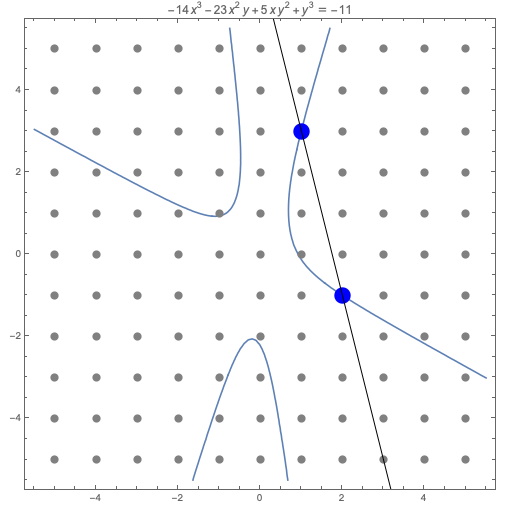It is easy to show, with an explicit construction, that a homogeneous cubic function $f: \mathbb{Z}^2 \to \mathbb{Z}$ is not injective. I am seeking a proof of the same result without the condition that $f$ is homogeneous.
For a homogeneous cubic:
$$f(x,y)=a x^3+b x^2 y+c x y^2+d y^3$$
if we take a generic point $(x_0,y_0) \in \mathbb{Q}^2$, the tangent to the curve:
$$f(x,y)-f(x_0,y_0)=0$$
will intersect the curve at a second point, $(x_1, y_1)$, with rational coordinates. To see this, note that we can parameterise the tangent line as:
$$L(\lambda) = (x_0,y_0) + \lambda\space (\partial_y f(x,y), -\partial_x f(x,y))|_{x=x_0,y=y_0}$$
Then the cubic in $\lambda$:
$$F(\lambda) = f(L(\lambda)) - f(x_0,y_0)$$
will have rational coefficients and a double root at $\lambda=0$, so its third root $\lambda_3$ must be real and rational. So:
$$(x_1,y_1) = L(\lambda_3)$$
will have rational coordinates, and will satisfy:
$$f(x_1,y_1) = f(x_0,y_0)$$
If we choose any integer $D$ such that:
$$(x_2,y_2) = D \space (x_0,y_0) \in \mathbb{Z}^2 \\ (x_3,y_3) = D \space (x_1,y_1) \in \mathbb{Z}^2$$
we can exploit the homogeneity of $f$ to obtain:
$$f(x_2,y_2) = D^3 f(x_0,y_0) = D^3 f(x_1,y_1) = f(x_3,y_3)$$
If $x_0, y_0 \in \mathbb{Z}$, we can write explicit formulas for $x_2,y_2,x_3,y_3$ as 7th degree homogeneous polynomials in $x_0,y_0,a,b,c,d$.
My question is: when $f$ is not homogeneous, can we construct explicit pairs of distinct points in $\mathbb{Z}^2$ that demonstrate $f$ is not injective?
For a quadratic in two variables with rational coefficients, there is a very simple choice of distinct integer points that demonstrate non-injectivity. Given:
$$q(x,y) = a x^2 + b x y + c y^2 + d x + e y + f$$
then
$$q(\alpha\space (-e,d)) = q(\alpha\space (e,-d))$$
and for rational $d,e$ we can choose $\alpha$ to make these points integers. If $d=e=0$ we can use any pair of integers $(x,y)$ and their opposite.
Note that the points we have constructed for the homogeneous case do not cover all pairs with repeated values. The plot shows an example of two points in $\mathbb{Z}^2$ with the same value for a homogeneous cubic that do not lie on a tangent to the level curve. Pairs like these can be found easily enough by a brute force computation, and they will typically have much smaller coordinates than those found via tangent lines, but I am not aware of any method to construct them directly.

